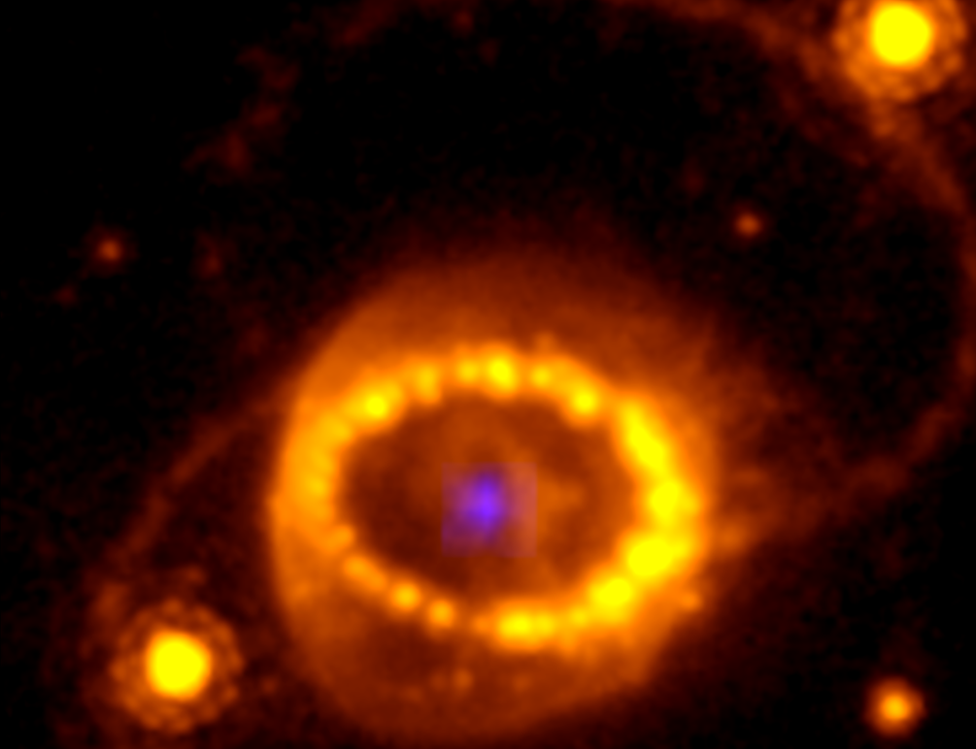Space explosion mystery finally solved
- Published
- comments

The neutron star in purple has been found to be at the centre of bright “string of pearls” ring of superheated gas
Scientists have got to the bottom of a 37-year-old mystery involving a huge cosmic explosion in a nearby galaxy.
The explosion was from a dying star and was so bright, with the power of 100 million suns, that it could be seen from Earth.
At the time there was so much debris, that even the most powerful telescopes could not confirm what was at the centre of the explosion.
Now new research has revealed the answer, confirming it is a neutron star.
What is a neutron star?
Artwork: Neutron stars have collapsed under the weight of their own gravity, crushing the atoms that once made them shine
Neutron stars are what's left of bigger stars after they've exploded.
Neutron stars aren't very big, about the size of a city, but they're incredibly dense meaning they're so tightly packed with stuff that a teaspoon of it would weigh 10 million tonnes.
В鶹№ЩНшКЧТіИлїЪ Sky at Night presenter Dr Maggie Aderin-Pocock said that the "mystery has been what lies in the shrouds of dust around what remains".
The explosion was of a huge star, 20 times the mass of our Sun, a so-called blue supergiant. Its life ended in spectacular style in a process called a supernova.
It was the first supernova to have been visible to the naked eye for 400 years.
Dr Aderin-Pocock once worked on a project to solve the puzzle of the supernova, which was given the code-name SN 1987A.
"The fact that it was visible gave it a celebrity status outside the world of science. And SN 1987A is also very close to the heart of astronomers because it was relatively close, and they were able to capture so much detail of the star's life cycle."
What happens when a star dies?
The star that exploded before the explosion (right) and the supernova after (left)
One theory of what happens when a star dies is that larger stars, bigger than our own Sun, collapse when they run out of fuel to carry out the nuclear reactions that make them shine.
When this happens the mass of the star is so great that its gravitational force crushes its own atoms to produce the densest material in the Universe, which is a neutron star, or if it is an even larger star, it can become a black hole.
Stars like our own Sun don't explode in a supernova. It's simply not massive enough. Scientists think that in about five billion years, when it has used up all its hydrogen fuel, our Sun will cool down and grow in size, becoming what is known as a red giant.
Astronomers are particularly interested in supernova because, as one star dies and explodes, it pushes out materials that eventually form to create new stars, planets and possibly even life.
But when it came to SN 1987A, scientists were puzzled as to what had exactly happened at the centre of the supernova explosion.
Now researchers writing in the journal Science say they have strong, if not overwhelming, evidence that it is a neutron star. Prof Claes Fransson, of Stockholm University in Sweden, who led the study, said this was the first time anyone had been able to probe the centre of the supernova and what was created there.
"We have been looking for this from the time of the explosion but had to wait to be able to verify the predictions,"
Nasa's James Webb Space Telescope (JWST) helped make the discovery.
The observations were made possible because of Nasa's James Webb Space Telescope (JWST). As well as being the most powerful space observatory ever built, it has instruments that take measurements at infra-red frequencies and so it can see past the space dust that has for so long blocked our view.
Prof Mike Barlow, of University College London (UCL), says although there have been several indirect hints, JWST has obtained "the first direct evidence'' that it is a neutron star.
"The mystery over whether a neutron star is hiding in the dust has lasted for more than 30 years and it is exciting that we have solved it."
Dr Robert Massey, of the Royal Astronomical Society added that "If we're lucky then in the next few years we might even see the neutron star in the centre properly, getting a relatively close look at one of these intriguing objects very early in its life."
- Published21 October 2017
- Published14 February
- Published2 October 2023
